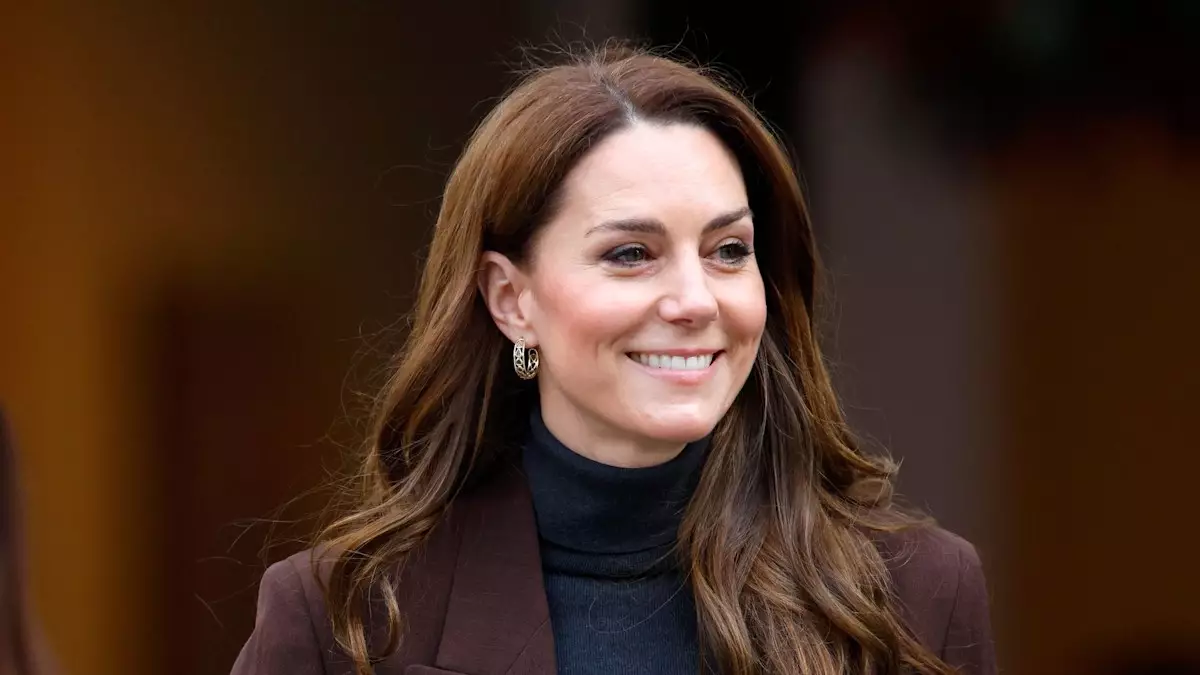The Princess of Wales, Kate Middleton, has recently made headlines for her fashion choices, particularly during her visit to the National Portrait Gallery. This appearance marked her first public outing amid renewed discussions about Kensington Palace’s policy to keep details regarding her outfits confidential. This policy, initially established three years ago, is aimed at focusing public attention on the causes she champions rather than her clothing choices. However, the decision to withhold outfit details has inadvertently stirred more interest in her sartorial selections, raising questions about the balance between personal branding and institutional guidelines.
During her appearance, Kate showcased a delicately curated outfit that was both chic and professional. She donned a brown tailored wool jacket designed by Petar Petrov, a Ukrainian-born designer based in Vienna, paired with a dark turtleneck sweater and wide-legged pinstripe trousers from the Italian label Max Mara. This choice reflects a significant evolution in Kate’s wardrobe—opting for contemporary designers and embracing international brands has shifted her fashion narrative.
While some may consider her outfit understated, it symbolizes a conscious choice to explore new avenues in fashion—away from the expected British labels that have defined her style in the past. The blending of muted colors and sharp silhouettes reinforces her status as a fashion icon while also hinting at a narrative of resilience, especially as she gradually returns to public life following her health struggles.
Petar Petrov’s association with the Princess is an intriguing one. Known for his impeccable craftsmanship and modern aesthetic, Petrov’s designs resonate well with Kate’s refined style. His pieces are characterized by clean lines and quality—qualities that are essential to her public persona. Additionally, Petrov is tied to Eponine London, a brand that has become a staple in Kate’s wardrobe over the years, comprising numerous admired outfits.
This strategic collaboration speaks volumes about Kate’s fashion strategy. By opting for a designer linked to an established British label while wearing international brands, she maintains a connection with her roots and the homegrown fashion industry, cleverly straddling both worlds. This nuanced approach draws attention to the twofold role she plays: a royal figure and a contemporary woman, reflective of a broader, more inclusive fashion landscape.
Despite the palace’s intentions to shift focus from fashion to philanthropic ventures, the reaction from fashion enthusiasts and the public has been complex. The decision to feature new pieces has led to intensified conversations about her style choices—especially when they do not align with her historical preference for British designers. Social media platforms, particularly Instagram, have seen a surge in discussions regarding her outfits, emphasizing the paradox that exists when a royal attempts to deflect focus from clothing.
As indicated by the creator of the Royal Fashion Police account, there is an undeniable curiosity surrounding what Kate wears, illustrating the intricate relationship between royal fashion and public perception. Although the intentions behind the new policy may have been to streamline Kate’s public narrative towards her advocacy work, it has effectively fueled greater interest in her clothing choices, revealing the limitations of attempting to control public discourse.
Kate’s gradual return to public duties accompanying her personal health journey adds another layer of depth to her fashion choices. Following her confirmation of being in remission from cancer, her appearance in new clothing can be seen as a metaphor—not just a stylistic update but rather an embodiment of strength and recovery. This transition in her public image is pivotal for connecting with her audience on an emotional level.
The Princess of Wales’s evolving fashion identity illustrates a delicate balance between royal traditions and modern expectations. Kate Middleton’s thoughtful attire choices, marked by both new designers and well-established British brands, signal her adaptability and personal agency. As she navigates this new phase in her public life, her fashion will continue to be scrutinized, revealing the lasting impact of royal style on contemporary culture.

